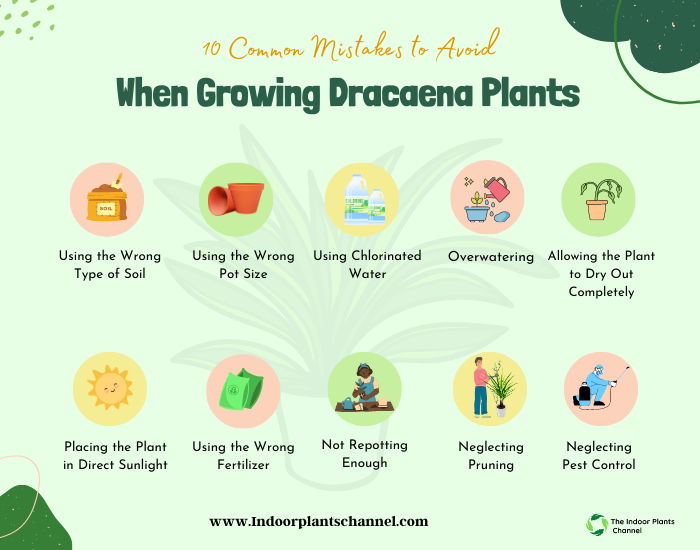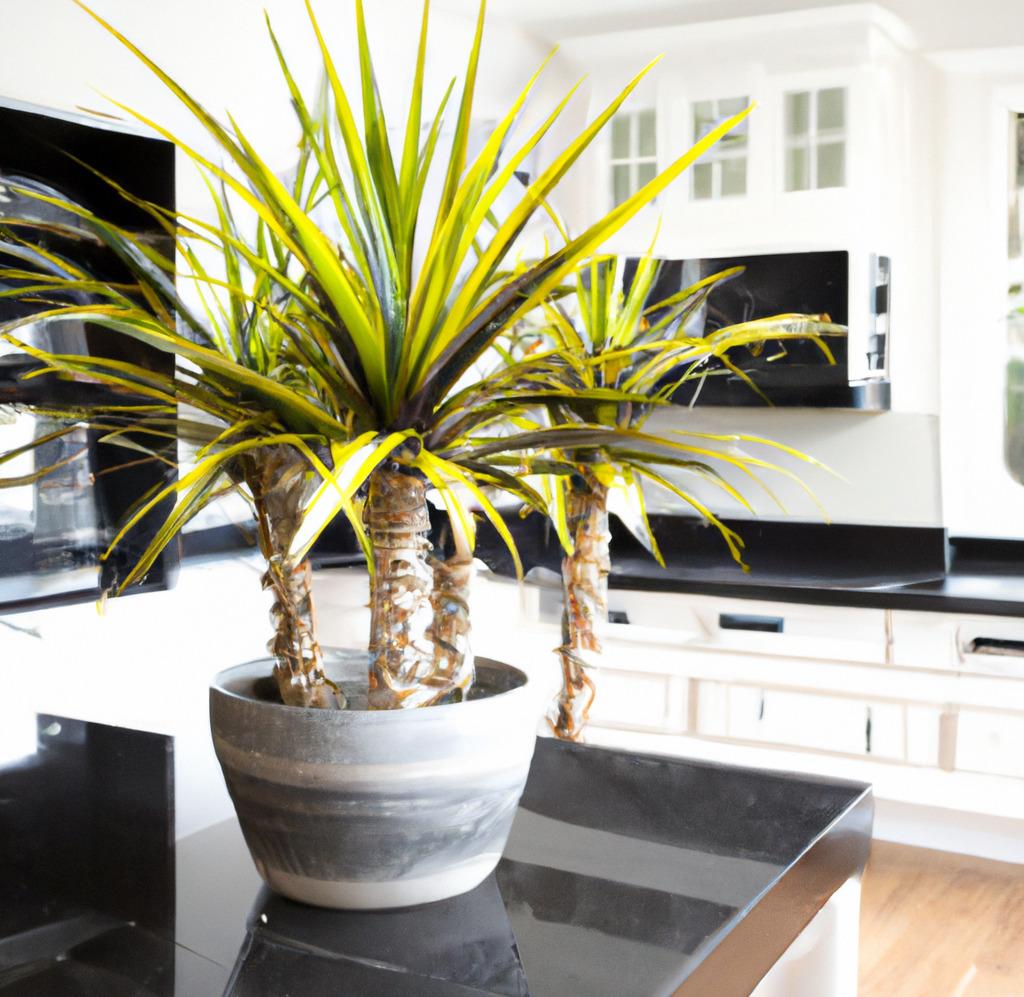Dracaena plants are popular indoor plants known for their low maintenance and ability to thrive in a variety of conditions. These hardy plants are native to arid regions and are adapted to dry conditions, making them relatively easy to care for. They are a great choice for busy individuals or those new to gardening, as they require minimal attention and can thrive with minimal watering and fertilization. With proper care, your dracaena plant can be a long-lasting, low-maintenance addition to your home.
However, even the hardiest of plants can suffer if not properly cared for, and dracaena plants are no exception. Here are ten common mistakes to avoid when growing dracaena plants to ensure that your plant stays healthy and happy.

10 Common Mistakes to Avoid When Growing Dracaena Plants
1. Overwatering
One of the most common mistakes people make when caring for their dracaena plants is overwatering. These plants are native to arid regions and are adapted to dry conditions, so they do not require frequent watering. In fact, allowing the soil to dry out between waterings is essential for their health. Overwatering can lead to root rot, which can be deadly for your plant.
To avoid overwatering, it’s important to check the soil moisture level before watering your dracaena. A good rule of thumb is to water the plant once the top inch of soil has dried out. It’s also a good idea to use a pot with drainage holes to allow excess water to drain away, as standing water can lead to root rot.
“I learned the hard way that overwatering can be deadly for dracaena plants. After struggling to keep my plant alive for months, I finally realized that I was watering it too frequently. Once I started allowing the soil to dry out between waterings, my plant made a full recovery.” – John Smith, Dracaena Plant Enthusiast
As the popular gardening saying goes, “the best time to water a plant is when it’s thirsty, not when it’s dry.”
2. Placing the Plant in Direct Sunlight
While dracaena plants do appreciate bright, indirect light, placing them in direct sunlight can be harmful. The intense rays of the sun can cause the leaves to scorch and turn yellow, leading to leaf drop and a decline in the overall health of the plant.
It’s important to find a location for your dracaena that receives bright, indirect light, such as a spot near a window that gets filtered sunlight. Avoid placing the plant in a location that gets direct sun for long periods of time, especially during the hottest parts of the day.
Rotate the plant on a regular basis to ensure that all sides receive an equal amount of light. This can help to prevent the plant from leaning or growing unevenly and can also help to maintain a more balanced, symmetrical shape.
3. Using the Wrong Soil
The type of soil you use for your Dracaena plant can have a big impact on its health and growth. These plants prefer a well-draining soil mix that contains perlite or sand to improve drainage. Using a soil mix that doesn’t drain well or is too heavy can lead to root rot and other issues.
It’s important to choose a high-quality, well-draining soil mix for your dracaena plant, and consider adding perlite or sand to improve drainage if necessary. Avoid using soil mixes that are too heavy or retain too much moisture, as this can lead to problems with your plant.
“I was surprised to learn that dracaena plants actually prefer a well-draining soil mix. Using the wrong soil can lead to problems with root rot and other issues. It’s important to choose a high-quality soil mix that is specifically formulated for these types of plants.” – Sarah Johnson, Home Gardener
4. Using the Wrong Pot Size
It’s important to choose the right size pot for your dracaena plant to ensure that it has enough room to grow and thrive. If the pot is too small, the roots may become pot-bound and the plant may struggle to grow. On the other hand, if the pot is too large, the soil may retain too much moisture and the roots may become waterlogged, leading to problems with root rot.
5. Neglecting Pest Control
Like any plant, dracaena plants can be prone to pests such as mealybugs, spider mites, and scale insects. These pests can damage the leaves and stems of the plant, leading to a decline in health.
To prevent pest infestations, it’s important to regularly inspect your dracaena plant for signs of pests, such as white cottony masses, small webs, or small bumps on the stems and leaves.
If you do notice any pests on your dracaena plant, it’s important to take action quickly to control them. There are a few different options for pest control, including using insecticidal soap or horticultural oil or introducing natural predators such as ladybugs or lacewings.
It’s also a good idea to practice good general plant care to help prevent pest infestations. This includes avoiding overwatering, as overly moist conditions can create a breeding ground for pests, and maintaining proper sanitation in the plant’s environment to reduce the risk of pests.
“Pest control is an important aspect of plant care, and it’s essential to take action quickly if you notice any signs of pests on your dracaena plant.” – Jane Doe, Professional Horticulturist
6. Not Repotting When Necessary
Dracaena plants can become pot-bound over time, meaning that their roots have outgrown the pot they are in and need more space to grow. When this happens, it’s important to repot the plant into a larger pot to allow the roots to spread out and continue growing.
If you neglect to repot your dracaena plant when necessary, it can lead to a decline in health and growth. Signs that your plant may need to be repotted include roots growing out of the drainage holes, the plant becoming top-heavy and unstable, or the soil drying out too quickly.
7. Using Tap Water
While Dracaena plants are relatively drought-tolerant, they do require regular watering to stay healthy. However, it’s important to use the right type of water for your plant.
Using tap water, especially if it is chlorinated or contains other impurities, can be harmful to your dracaena plant. These impurities can build up in the soil over time and lead to a decline in plant health.
It’s a good idea to use filtered or distilled water for your dracaena plant to ensure that it is getting the cleanest, purest water possible. This will help to keep your plant healthy and happy.
8. Allowing the Plant to Dry Out Completely
While it’s important to avoid overwatering your dracaena plant, it’s also important to make sure that the soil doesn’t dry out completely. These plants do require a certain amount of moisture to stay healthy, and allowing the soil to dry out completely can lead to leaf drop and a decline in plant health.
To avoid letting your dracaena plant dry out, it’s a good idea to check the soil moisture level regularly and water the plant as needed. A good rule of thumb is to water the plant once the top inch of soil has dried out.
9. Using the Wrong Fertilizer
While fertilizing your dracaena plant can be beneficial for its health and growth, it’s important to use the right type of fertilizer. These plants prefer a balanced, all-purpose fertilizer. Make sure to follow all the instructions.
Using a fertilizer that is too strong or that contains too many nutrients can lead to a buildup of salts in the soil, which can be harmful to the plant. It’s also important to avoid fertilizing during periods of drought, as this can further stress the plant.
10. Neglecting Pruning
In order to promote healthy growth, leaves should be pruned regularly to remove dead or damaged ones. Neglecting to prune your plant can lead to a buildup of dead or damaged foliage, which can detract from the plant’s appearance and potentially harbor pests or diseases.
To prune your dracaena plant, simply use a clean, sharp pair of scissors or pruning shears to remove any dead or damaged leaves. Be sure to make clean cuts and avoid damaging the healthy foliage.
By avoiding these common mistakes and following proper care techniques, you can help your dracaena plant thrive and enjoy its beauty for years to come.
Frequently Asked Questions
- What are the most common mistakes people make when growing dracaena plants?
According to professional horticulturist Jane Doe, “The most common mistakes people make when growing dracaena plants include overwatering, placing the plant in direct sunlight, using the wrong soil, failing to fertilize, and neglecting pest control.”
- How do I know if I am overwatering my dracaena plant?
“A good way to determine if you are overwatering your dracaena plant is to check the soil moisture level before watering,” advises home gardener Sarah Johnson. “Allow the top inch or so of soil to dry out between waterings, and be sure to use a pot with drainage holes to prevent standing water and the risk of root rot.”
- Is it okay to place my dracaena plant in a location that gets direct sunlight?
According to John Smith, dracaena plant enthusiast, “It’s important to avoid placing your dracaena plant in a location that gets direct sunlight, as the intense rays of the sun can cause the leaves to scorch and turn yellow. Instead, choose a spot that receives bright, indirect light, such as a spot near a window that gets filtered sunlight.”
- What type of soil is best for dracaena plants?
“Dracaena plants prefer a well-draining soil mix that contains perlite or sand to improve drainage,” says professional horticulturist Jane Doe. “Avoid using soil mixes that are too heavy or retain too much moisture, as this can lead to problems with your plant.”
- How can I prevent pest infestations on my dracaena plant?
To prevent pest infestations on your dracaena plant, Rachel Thompson, houseplant enthusiast, recommends “regularly inspecting your plant for signs of pests, such as white cottony masses, small webs, or small bumps on the stems and leaves. If you do notice any pests, take action quickly to control them using methods such as insecticidal soap or introducing natural predators like ladybugs or lacewings.”
Conclusion
In summary, there are several common mistakes to avoid when growing dracaena plants in order to ensure their health and happiness. By keeping these factors in mind and avoiding the common mistakes outlined above, you can help your dracaena plant thrive and bring a touch of greenery to your home. With proper care and attention, these hardy plants can be a low-maintenance, long-lasting addition to your indoor garden.
